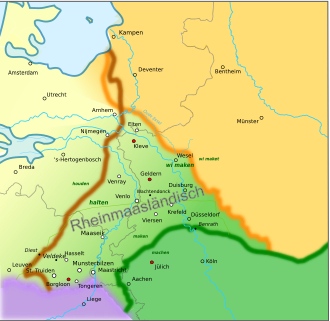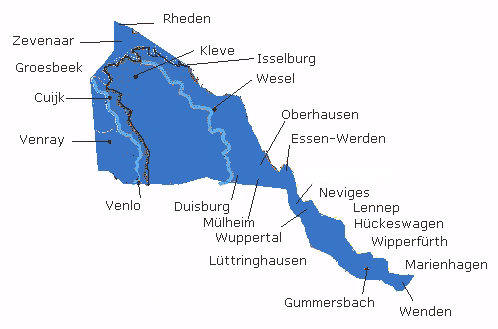Rheinberger Platt
The Rheinberger Platt or the Rheinberger dialect, self-named Rinbäärkse Plat, is a Lower Franconian dialect variant that is spoken in the Lower Rhine city of Rheinberg and the villages of Ossenberg , Millingen , Alpsray , Budberg and Eversael , which today belong to Rheinberg . Rheinberg belongs to the northern Lower Franconian dialect dream, marked u. a. by using the personal pronoun "ek" instead of "I". In southern Lower Franconia on the other side of the Uerdinger line , “esch” or “isch” is used instead.
Origin of the dialect
From the 3rd century onwards, Franconian tribes penetrated from the right bank of the Rhine into the left bank of the Rhine and expanded into the areas that were partly populated by Romans and Gallo- Romans . The Salfranken expanded through the present-day Netherlands and Belgium to present-day France . The Rhine Franks (later also called Ripuarier ) spread along the Rhine and made Cologne their royal seat. In the 6th century, the Merovingian king Clovis I united the two Franconian peoples into one people and founded the first Franconian Empire .
Today's Middle and Lower Franconian dialects are derived from these Franks, which are located on the Rhine and expand towards the west.
Lower Franconian and Rhine Maasland
The Rheinberger dialect, usually called Rheinberger Platt or Rinbäärkse Plat , belongs to Lower Franconian , which also includes the southwestern dialects of Dutch . In this dialect dream, a local written and office language emerged in the 14th century, the Rhein-Maaslandisch so called today (see map). While Dutch - also in the form of Afrikaans - has developed into an independent written language, the Lower Franconian dialects in German territory have become dialects within German as the umbrella language. However, in the 18th century on the Lower Rhine, in addition to Standard German, Dutch was also used as a written language, with a third variant of a German-Dutch mixed language. More information on the genetic classification, in particular the historical relationship to other dialect groups, can be found in the article Germanic languages .
The Lower Franconian dialects are represented in Germany, the Netherlands and Belgium. Geographically, it forms an area that is in the northeast of the Westphalian dialects (which belong to Low German), in the northwest of Brabant (also Lower Franconian), in the southwest of Walloon (i.e. French) and in the south of Ripuarian (a Middle Franconian dialect group with the center Cologne ) is limited. The border line in the south forms the so-called Benrath Line , which runs from Aachen via Jülich to Düsseldorf and separates Low German and Low Franconian from High German dialects (maken versus making, ik versus me). There is also the Uerdinger line ; to the south of it the personal pronoun "ich" is spoken as "isch", to the north of it, on the Lower Rhine, as "ek". The striking northeast border between the Lower Franconian and Low German runs on the right bank of the Rhine roughly on the Bocholt - Recklinghausen - Dortmund line, the border to the closely related Brabant within today's Netherlands, for example, from Leuwen via Nijmwegen to Arnhem.
The Kleverland dialect group and its southern transition dialects
Kleverländisch (North Lower Franconian) includes the dialects on the left bank of the Rhine in the Kleve, Goch, Xanten, Kevelaer, Straelen, Kempen, Moers, Vluyn, Rheinberg area as well as the dialects on the right bank of the Rhine from Emmerich to Duisburg. However, the Ostberg region from Mülheim an der Ruhr to Gummersbach also has characteristics of this group. The southern part is made up of the southern Lower Franconian transition dialects to Ripuarian, as spoken in the Mönchengladbach - Krefeld - Düsseldorf area; it is also known as East Limburg. The dividing line between Kleverland and the southern Lower Franconian transition dialects is the Uerdinger line . So z. B. Krefeld's Platt Krieewelsch `already has numerous characteristics of the Ripuarian dialect, such as B. esch instead of ik ("I"), the j-initial sound instead of / g / ( jedöns "Gedöns"), velarization of the alveolar (more commonly "under") and a form of the typical Cologne "singsong". The Hölsch Plott spoken in the Krefeld district of Hüls, on the other hand, uses "ek" or "ec" and has predominant characteristics of Northern Lower Franconia .
Differences within Kleverland
Of course every village has its linguistic peculiarities. Within Kleverland, Rheinberger Platt consists of a group of very similar local dialects that are also spoken in the neighboring villages of Ossenberg , Millingen , Alpsray , Budberg and Eversael . The Rheinberger Platt is quite different from the neighboring Grafschafter and Vluyner Platt to the south or the Straelener dialect spoken to the southwest, but also from the Gocher variant to the north. The main differences lie in the implementation of the old West Germanic long vowels and diphthongs / i: /, / u: /, / au / and / ai / (source Horster 1996).
Regional differences of the Kleverland dialects
| Goch | Rheinb. | Straelen | Vluyn | Duisburg | |
|---|---|---|---|---|---|
| time | tit | tit | tiit | tiit | tiit |
| House | hush | hush | huus | huus | huus |
| herb | krüt | krüt | kruut | kruut | krout |
| tree | boom | boom | buem | boum | boum |
| leg | been | been | bien | leg | bäin |
The fact that there are subtle differences even within the Rheinberger Platt can be seen in the different implementation of West Germanic / u: / and / au / (Horster 1996).
Differences within the Rheinberg dialect
| Osbg. | Mill. | Alps. | Rhbg. | Budb. | Evers. | ||
|---|---|---|---|---|---|---|---|
| House | hüs / hus | ü | ü | ü | ü | ü | u |
| herb | krüt / krut | ü | ü | ü | ü / u | u | u |
| fence | do / do | ü | ü | ü / u | u | u | u |
| brown | brun | u | u | u | u | u | u |
| Dove | duuv | uu | uu | uu | uu | uu | uu |
The abbreviations mean: Osbg. = Ossenberg, Mill. = Millingen, Alps. = Alpsray, Rhbg. = Rheinberg, Budb. = Budberg and Evers. = Eversael.
Dialect preservation and language use
Josef Gormanns published a dictionary of Rheinberger dialect in 1989 and Theodor Horster published a Rheinberg dictionary in 1996 , both of which have taken a decisive step towards preserving the Rheinberger Platts. While the oldest residents of Rheinberg and the surrounding villages still occasionally talk to each other in the Platt, the group of middle-aged local citizens can barely understand, the younger ones or children hardly come into contact with the Lower Rhine dialect.
As an example of the Rheinberg dialect, a few sentences from a report on the great flood with ice drift from 1929 from Gormanns 1989 (in simplified notation):
“In february neegentinhondertneegenontwentech, as man glöwne, de wenter trök af, as di Rinberkse six of da fastelowent froine, brook öwer nach 'äne strict wenter herin, Schlemmer as 1890, woerfan aale lüj dumols yarn vertellne. Öwer därtech grat onder null freeze et schteen on been. Nor wenech daach schtoon dä Rin. "
“In February 1929, when it was believed that winter was about to depart, (and) when the people of Rheinberg were looking forward to Carnival, a severe winter fell overnight, worse than 1890, which old people liked to talk about at the time. (At) over 30 degrees below zero it froze stone and leg. After a few days the Rhine was standing. "
The Lower Rhine Regiolect
The Lower Rhine regional dialect (also Regiolekt ) should be placed on a level between the standard German language and the local dialect , a variant of Standard German with dialectic sprinkles, especially in the phonetic and lexical area, which is used today by many Lower Rhine people as a colloquial language:
- Standard German: Tell me what that is.
- Niederrheinischer Regiolekt: Tell me ma, wat dat is.
- Rheinberger dialect: Vertell mik es, wat dat is.
- Standard Dutch : Vertel mij eens, wat dat is.
literature
Rheinberger Platt
- Gormanns, Josef: Dictionary of the Rheinberger dialect. Writings of the city of Rheinberg on history and local history,
volume 2. Stadt Rheinberg 1989. - Gormanns, Josef (Ed.): Ons Modersprook in Rhinberk on Ömgägend. Two volumes. Michael Schiffer, Rheinberg 1980 and 1981.
- Horster, Theodor: Rheinberger Dictionary. A documentation of the dialect in the lower Lower Rhine. With an introduction by Georg Cornelissen. Rheinland-Verlag, Cologne 1996.
- Bakker, Frens & Kruijsen, Joep: Het Limburgs onder Napoleon, Achttien Limburgse en Rijnlandse dialectvertalingen van 'De Verloren zoon' uit 1806–1807. (On pp. 130–132 there is a translation of the parable of the prodigal son into the Rheinberg dialect from 1806!)
Related
-
Georg Cornelissen : On the language of the Lower Rhine in the 19th and 20th centuries.
In: Dieter Geuenich (Ed.): The Lower Rhine cultural area in the 19th and 20th centuries. Peter Pomp, Bottrop - Essen 1997. - Elmentaler, Michael: The history of writing language in the Lower Rhine.
In: Dieter Heimböckel (Ed.): Language and literature on the Lower Rhine. Peter Pomp, Bottrop - Essen 1998. - Hantsche, Irmgard: Atlas for the history of the Lower Rhine. Peter Pomp, Bottrop - Essen 2000.
- Tervooren, Helmut: The linguistic situation on the Lower Rhine in the 16th to 18th centuries.
In: Dieter Geuenich (Ed.): The Lower Rhine Cultural Area. From antiquity to the 18th century. Peter Pomp, Bottrop - Essen 1996. - Wittrup, Aloys : From Rheinberg's past days. Michael Schiffer, Rheinberg 1955.
See also
Web links
- Sound sample from the Rinbäärkse Plat of the language department at the LVR Institute for Regional Studies and Regional History at the Rhineland Regional Council



